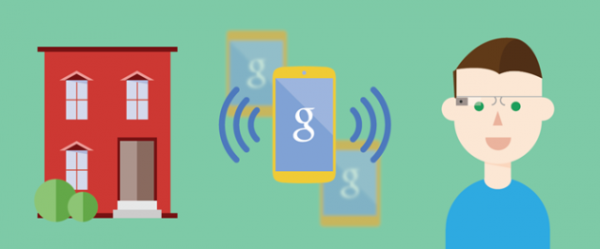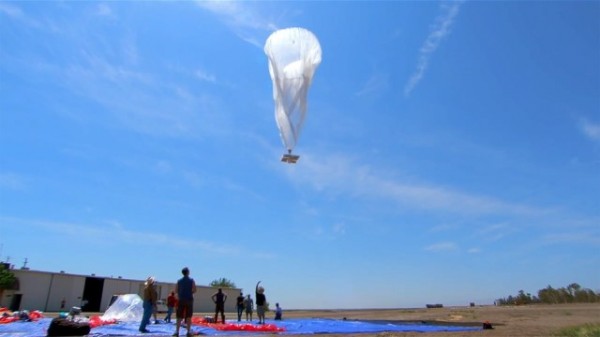Walyou |  |
- Google Nearby Opens The Door For Indoor Mapping and Automation
- It doesn’t get more badass than an X-Wing made out of knives
- Google wants you to be online: Project Loon brings internet everywhere
- LIVV Headphones Withstand High-Impact Training Conditions
| Google Nearby Opens The Door For Indoor Mapping and Automation Posted: 17 Jun 2014 07:00 AM PDT  Google may be preparing to launch a new technology to improve indoor mapping, targeted advertising, and home or office automation. Anyone that remembers life before smartphones might remember the days when navigation was done using signs, landmarks, and paper maps. GPS and mapping features are some of the most popular apps and features provided by modern technology, but the services are largely take for granted. Mapping technology is incomplete, though. Since GPS relies on signal from satellites, maps (usually) requires line of sight to the sky in order for service to function properly. Google has improved mapping some by using locally mapped WiFi signals to triangulate a rough approximate location as a supplement to improve the accuracy of GPS, but still doesn’t solve for major gap in navigation: it doesn’t work indoors. Anyone that has ever tried to navigate a shopping mall might be familiar with trying to orient a mall kiosk map in order to find a specific storefront. This is one area that smartphones would be of great use, except GPS doesn’t work indoors, and WiFi isn’t prevalent enough to provide an accurate location. Apple has previously launched its “iBeacon,” which is a Bluetooth low energy beacon that helps establish way-points. Now Google is rumored to be launching a similar service called “Nearby.” So far, a lot of the uses for similar Bluetooth devices, such as iBeacon, has been to enable advertisers to target potential customers (go figure). For example, a mannequin in a clothing store could be equipped with a beacon, and when it detects a phone from a nearby customer (if allowed by the customer’s privacy settings) and it could automatically push a notification containing a coupon for whatever item of clothing the mannequin is dressed in. This type of function is fairly common for many new technologies, as they need to have a way to generate revenue in order to encourage adoption and fund the research and development of additional features. If Google is entering the market with Nearby, then there could be a boom of these devices being implemented in many new ways. The market for indoor mapping, as specified above, is virtually untouched currently, but there’s also a huge opportunity for implementation in home automation and office automation. For home automation, it could function hand in hand with products like Nest (another Google product) to determine how many people are in various rooms in order to efficiently provide heating or cooling. It could also be incorporated with smart lighting so that lights turn on and off as you enter or exit a room. Or even more fun, change the mood lighting (brightness, color) based on how many people are in a room and the level of activity. Outside of the home, offices are finding a massive productivity boost from the use of automation features. Many companies find that there’s a paradox in office communication. Email is becoming less and less productive from overuse, but as a result, conference rooms are also getting overbooked and unavailable. some companies–such as Solstice Mobile, the leading provider of enterprise innovation and mobility solutions–have created full blown smart-offices, relying heavily on Bluetooth beacons. This creates efficiencies across the board, because power is better conserved by dimming lights and other power draws to inactive areas, but also efficiencies in work productivity. Workers can find where their colleagues are located at any time in order to have a quick face to face meeting, reducing both email and conference room congestion. There are entire categories of untapped features that could be utilized as services such as Google Nearby become more prevalent, in addition to the augmenting of existing popular services, such as maps and navigation. Of course some people might not be the biggest fans of many of the effects of this service, due to very valid privacy concerns, but fortunately there are enough applications in the privacy of your own home or office to give any technology fan something to be excited about! |
| It doesn’t get more badass than an X-Wing made out of knives Posted: 17 Jun 2014 06:00 AM PDT  Silverware doesn’t really scream “cool” or “geeky” when you think about it, but after fusing that with Star Wars, you would be surprised by how much you may change your mind. You don’t need a Jedi pilot to slice those cucumbers! The Star Wars X-Wing Knife Block is a set of silverware themed after the X-Wing Fighters we’ve seen and loved in the original Star Wars trilogy. You may pre-order it now, as it’s an official piece of merch, too! Few things sound as terrifying as a flying set of knives, but hey, that’s nothing the force can’t control, anyways. Source: Technabob Be social! Follow Walyou on Facebook and Twitter, and read more related stories at Gravity-Defying Star Wars-esque Aero-X Hoverbike to Be Launched in 2017 and Darth Vader Helmet Toaster: Humilliating And Awesome. |
| Google wants you to be online: Project Loon brings internet everywhere Posted: 17 Jun 2014 05:00 AM PDT  If we say that Google is experimenting with balloons, readers would think of it as a ludic activity, but it turns out it’s one of Google’s most altruistic endeavors yet. So, what is Google’s Project Loon, and why does it matter? Well, it’s just basically Google trying to get internet everywhere in the globe. Literally everywhere. There is a city in Brazil called Campo Maior, which has restricted Internet access because of its remote location and lack of infrastructure. We’re talking “try to climb up on a tree to see if your cellphone works” issues. Yet, a few days ago, Campo Maior’s was one of the first beneficiaries of Google’s Project Loon, that is, they had internet beamed directly to them from a balloon relay. No cables, no optic fibers, just a high-elevation Wi-Fi balloons. The California company had set their goals high: to bring Internet to every corner of the Earth, and now after a full year of work, we begin to see the first results of such an endeavor. As the Google team explained in the Project Loon Google+ page, there are lots of factors to take into account, and different weather conditions all across the Earth, but if those kinks got ironed, they’d be able to “provide Internet signal directly to mobile phones, opening up more options for bringing Internet access to more places.” One of their first balloons, the Ibis-167, went around the world in just 22 days, and there are already more on the way which are supposed to stand on air for over 100 days at a time. This would extend to provide up to 4G services for phone devices, too, which we’re sure many countries would benefit from. Head of Google X Astro Teller has voices his hope that the company would soon be able to move beyond their test phase, and bring Internet to the masses. We, for one, can’t wait. Source: CNET Be social! Follow Walyou on Facebook and Twitter, and read more related stories at Google's Acquisition Spree Reaches into Space and Google Is Rumoredly Planning to Launch Android TV at I/O This June. |
| LIVV Headphones Withstand High-Impact Training Conditions Posted: 16 Jun 2014 01:57 PM PDT  Listening to music while doing physical activities can have a major impact on your motivation, but depending on the intensity, your headphones might fell off. Unless they’re LIVV headphones, that is. Former American footballer Mark Clayton created a pair of headphones that are meant to stay on your head after you put them on. American football is obviously rougher than jogging or going to the gym. In other words, Clayton had a first hand experience of that it happens when you want to listen to music while doing high-impact training. Clayton stated that “I’ve tried everything in the market headphone-wise. In-ears are the best for function, but the bud can become irritating after a while of having it jammed down your ear. Over-ear headphones, which are the most widely available, are more comfortable, but don’t stand a chance in intense activity.” With that in mind, Clayton started working in 2011 on a pair of wireless headphones that could withstand high-impact training conditions. The band that wraps around the head of the wearer is contortional, fact that keeps it in place. Since these are wireless, they obviously connect to your smartphone or portable media player via Bluetooth. Users have 5GB of internal storage at their disposal. Once fully charged, the battery should provide 4 to 5 hours of playback or talk time, since these headphones can obviously be also paired to smartphones for talking. Dale Lott of Aurisonics, the man in charge for engineering these headphones, detailed the technical specs of the drivers: “We chose a 40 mm titanium driver for its superior frequency response between 10 Hz and 22 kHz.” The Livv heaphones also include the aptX codec that make the HTC One M8 and the Xperia Z2 tablet such great devices in terms of sound quality. Clayton has started a crowdfunding campaign for the LIVV headphones on Kickstarter, where people can pledge $179 or more in order to secure a pair of Livv headphones for themselves. At press time, there were 56 more days to go and about $190K left to raise from the $200K goal. Should the campaign be successful, backers will get their headphones in April 2015. Hopefully, the Livv headphones will hit the market and will make the other sports earphones just a long-forgotten memory. Be social! Follow Walyou on Facebook and Twitter, and read more related stories about the Split standalone PMP that’s totally hands-free, and Beep, the gadget that turns dumb speakers into smart ones. |
| You are subscribed to email updates from Walyou To stop receiving these emails, you may unsubscribe now. | Email delivery powered by Google |
| Google Inc., 20 West Kinzie, Chicago IL USA 60610 | |